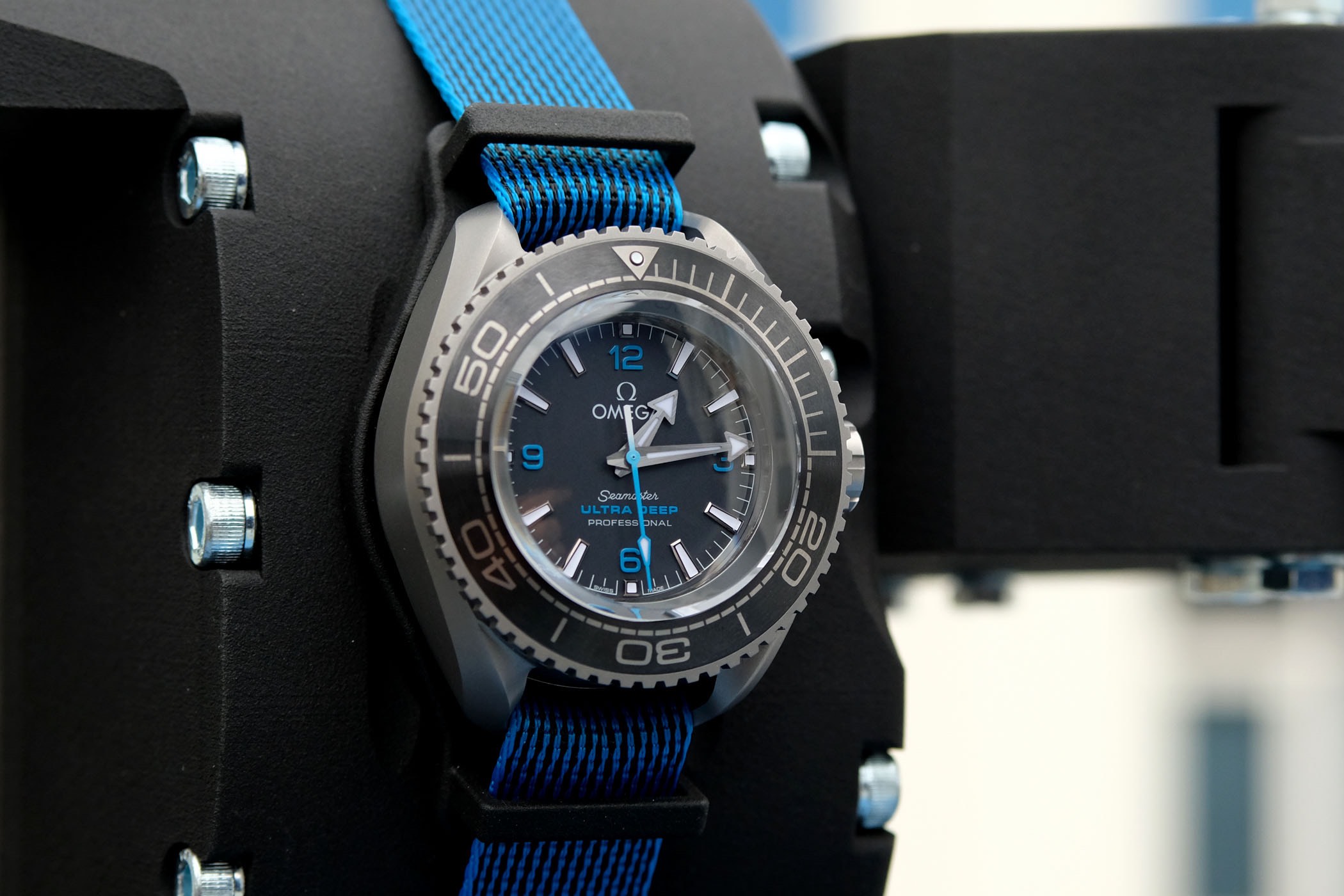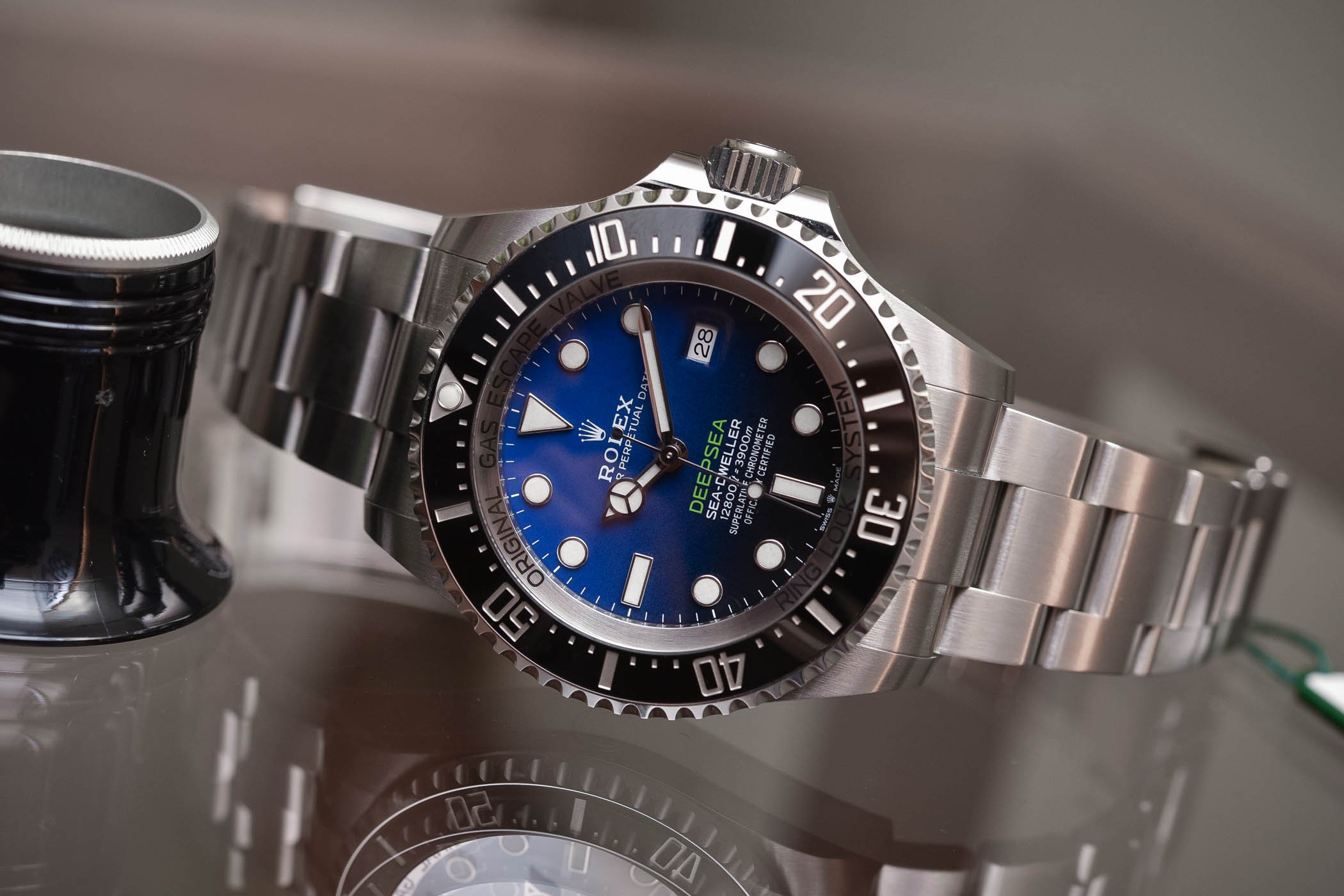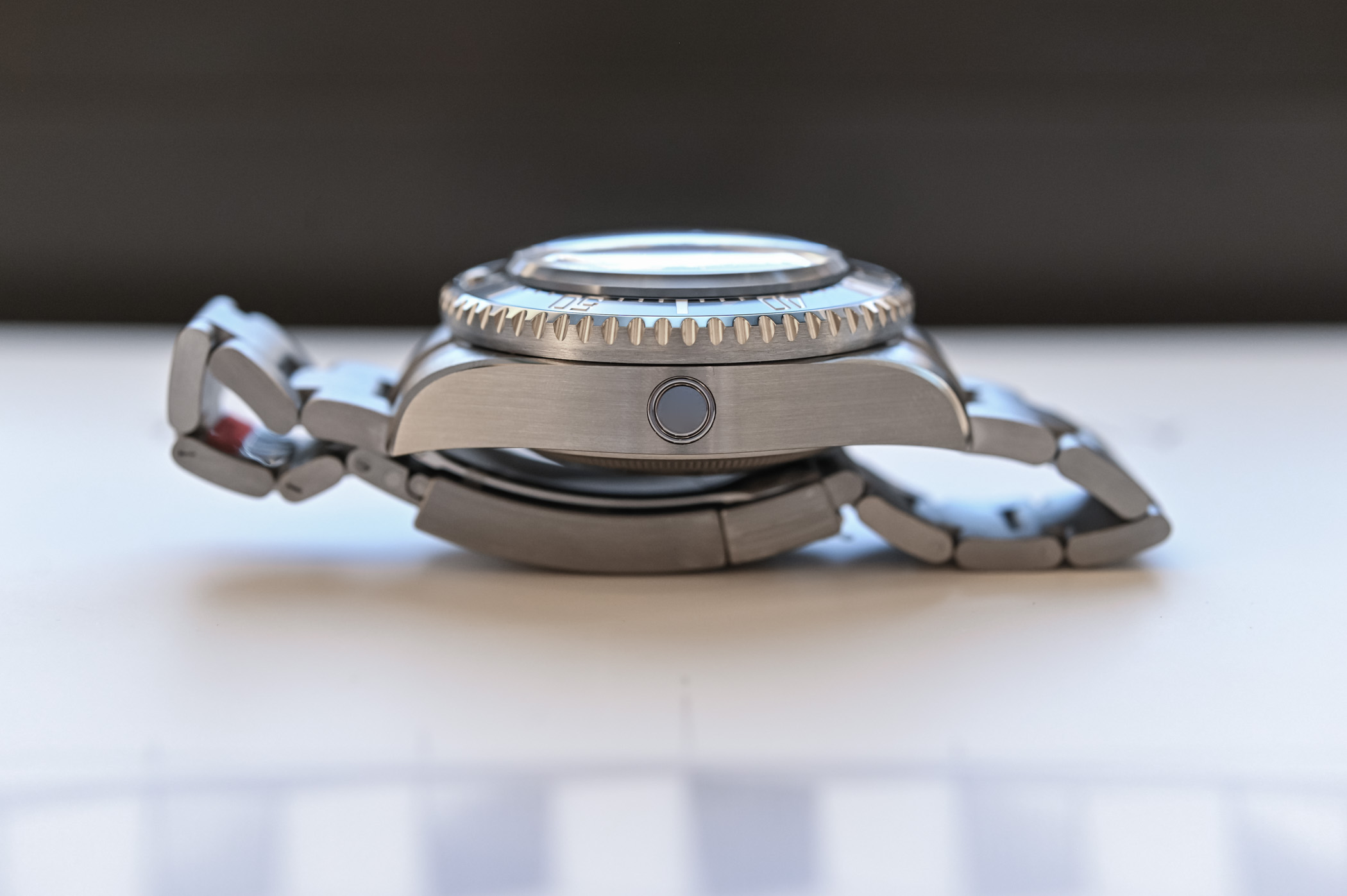The Beast Of The Depths, The Titanium Rolex Deepsea Challenge 126067
What was once an experimental project is now part of the current collection... and you can actually take it down to 11 kilometers!

A month ago, Rolex revealed a new model… And not just a new variation around an existing watch, but simply their most advanced dive watch ever, the Deepsea Challenge. What was once an experimental model made specifically for a man and his record dive at the deepest point of our planet (which has since been beaten by another man and another brand) is now becoming a watch “available” to the public. Compared to the experimental watch, the new Deepsea Challenge is better one, if we’re honest. Much has been said about this watch. It can resist incredible pressures, it’s an outstanding technical achievement, it’s the first Rolex made entirely of titanium and it’s a barely wearable beast of a watch. But there’s more than the numbers, so it’s time to dive deep (easy, I know…) into what this new Rolex Oyster Perpetual Deepsea Challenge 126067 means.
The current state of the deep dive watch industry
Behind this Deepsea Challenge is actually almost 70 years of research and development by Rolex and its partners – Comex, military forces, and explorers like the Piccards or James Cameron. What Rolex describes as their ultimate watch of the deep is the direct successor of multiple experimental watches, starting in the late 1950s with the original Deep Sea Special – a watch that made the trip down to the bottom of the Mariana Trench (10,916 metres or 35,814 feet) with Piccard father and son in 1960. And if you’re interested, it is on display, together with the Trieste, at the Smithsonian Institution in Washington DC. Fast forward to 2012 when Rolex broke another record with movie director James Cameron, providing an experimental Deepsea Challenge watch that accompanied him on his historic 10,908-metre (35,787-foot) descent. The latter is an important watch since it’s actually the starting point of the development of this commercially-available Deepsea Challenge 126067.

In the meantime, a man named Victor Vescovo achieved the culmination of his Five Deeps project becoming the first human to dive to the bottom of the deepest point of all five of the world’s oceans. And during his trip down the Mariana Trench, Vescovo made it deeper than Cameron, reaching a depth of 10,928 metres – a record that seems difficult to beat. Attached to the exterior of his vessel were three Omega Seamaster Planet Ocean Ultra Deep Professional models conceived specifically for this mission, watches that were officially tested to resist a pressure of 1,500 bars or the equivalent of a 15,000-metre depth.

This is for the experimental side of things. What about watches that can be bought from a classic watch retailer? Well, even though there is no official definition, the concept of deep dive watches (at least in my books) concerns everything that can resist at least 100 bars, meaning depths of 1,000m of 3,300ft and more. In all honesty, these ratings are already reaching the point of unnecessary, since no man has ever dived – at least without being inside a pressurized vessel – below the 675-metre mark, which is the current record, done by French Comex diver Théo Mavrostomos on 20 November 1992 during an experimental dive (and keep in mind that this record has required an incredible compression and decompression process of multiple weeks, as well as a highly specific breathing mixture).

There are not that many watches capable of resisting 100 bars and beyond. Some examples are the Omega Ploprof (1,200m), the Rolex Sea-Dweller (1,220m), the Doxa SUB 1500T (1,500m), the Sinn U2 EZM 5 (2,000m), the Rolex Deepsea Sea-Dweller (3,900m) or the Delma Blue Shark III (4,000m). Recently, Omega unveiled the commercial version of its Seamaster Planet Ocean Ultra Deep, with a 6,000m water-resistance (and keep in mind that watches under the Master Chronometer certification are subjected to an additional 25% pressure, meaning a whopping 750-bar pressure, or about 7,500m). That’s not all. The Bell & Ross Hydromax, a quartz-powered watch with a silicon-filled case and with very compact proportions, was available in the early 2000s, with a rating of 11,100m. Finally, a German brand named H20 Watch advertises a watch named the Kalmar 2 Deep Diver as tested and officially certified by a German institute to withstand a pressure of more than 2500 bars or about 25,000m.

Let me just say this… Whatever the records, any watch that can go at depths beyond 3 or 4 kilometres is properly impressive, and Rolex’s Deepsea Challenge and its 11,000m rating is simply outstanding. The forces and pressures at stake at such depths are immense, specifically when you consider these apply to an object barely 5cm in diameter. Let’s now see how Rolex made this possible.
The Rolex Deepsea Challenge 126067, The Facts
What is the new Deepsea Challenge all about? Basically, it’s Cameron’s watch made available to the public. In fact, it goes even beyond that. This new model is actually better and more advanced in multiple ways. It has almost the same level of resistance but is smaller (or less gigantic), lighter and comes with more advanced materials. The original 2012 Deepsea Challenge of Cameron, which made it to the Mariana Trench, is a stainless steel monster with a depth rating of 12,000m (that’s 13.6 tons of pressure… imagine a bus crushing your chest), a 51.4mm diameter, a 28.5mm thickness, a 14.3mm thick sapphire crystal, and a weight that is probably close to 400 grams.
The new Rolex Deepsea Challenge 126067 shares many of its design elements and its overall conception with Cameron’s watch, but it actually improves it in multiple aspects. Let’s start with the materials. This watch is the first-ever Rolex entirely made of titanium. Rolex has used titanium in the past for the caseback of the Deepsea Sea-Dweller, or in a Yacht-Master 42 prototype made for Sir Ben Ainslie. The only full-titanium watch that the group has done (commercially-speaking) is the Tudor Pelagos, but never a Rolex-stamped watch has been entirely made out of titanium. The alloy used by Rolex here is dubbed RLX Titanium, which is the internal name for a grade 5 alloy. Titanium has multiple advantages in the present context and makes much sense. It’s highly resistant to corrosion, it’s about 40% lighter than steel (not a small detail for such a beast) and it has more mechanical resistance too, which is always useful to resist such pressures.
Let’s talk dimensions… I won’t hide the reality, the Rolex Oyster Perpetual Deepsea Challenge is a gigantic watch. Period! Diameter: 50mm. Height: 23mm. Lug-to-lug: 61mm. Thickness of the crystal: 9.5mm. Weight: about 250 grams. However, just look again at the specifications of Cameron’s Deepsea Special. Everything has been shrunk down, and not by a small margin. I’m not saying it makes the 126067 a compact watch, but it shows the work done by Rolex between the experimental model and the commercial watch. And keep in mind that without the brand’s Ringlock system, the whole watch would be even thicker.

How is it possible to create a watch that can withstand about 1100 bars or 13 tons of pressure? Well, it’s the combination of multiple elements, starting with a well-secured crown and high-resistance gaskets, in this case, a Triplock crown. Then, it’s mostly the Ringlock system that does the job. Patented in 2007, Ringlock consists of a compression ring that absorbs most of the stress due to the pressure and reduces the stress on the case. This compression ring made of BioDur 108 (an alloy used in orthopaedic implants) can withstand three times as much stress as Oystersteel (or 904L steel). It is positioned between the crystal and the titanium back, diverting most of the stress on its extra-tough structure. With it, the case can be made thinner and so does the crystal (relatively speaking, of course).
As for other diving credentials, the Deepsea Challenge is basically a fully equipped, yet rather classic dive watch. The caseback is screwed (of course), the left side of the case features a helium escape valve and the crown is protected by lateral guards. The thick crystal is framed by a unidirectional bezel with a Cerachrom insert, a glossy black ceramic insert with an engraved fully-graduated 60-minute scale filled with platinum. And yes, the watch is officially rated for 11,000m or 36,090ft, but keep in mind that Rolex applies an extra 25% pressure to the testing procedure – meaning 13,750m – thanks to specific equipment developed with its long-time partner Comex.
About the design of the watch, it is certainly a no-surprise model. Conservative in most aspects, it basically looks like a beefed-up Deepsea Sea-Dweller 126660. At least from a distance. There are multiple details to differentiate this Deepsea Challenge, though. The case is mostly brushed, even on the sides (that’s new) and features polished bevels on the lugs (that’s old). Not sure why Rolex chose to bring these chamfers back – maybe to visually reduce the size of the watch – but they look great, yet maybe not completely adequate in such an instrumental watch.
As for the proportions and the wearability, let me go straight to the point. I know the efforts done by Rolex to make this Deepsea Challenge 126067 smaller, thinner and lighter than Cameron’s watch, but it remains nevertheless a gigantic, barely wearable watch. Surely, deep down and over a wetsuit, it’ll look just purposeful. But on a daily basis, in casual attire, it’s a massive watch. Just see it next to an already large Deepsea Sea-Dweller (a 44mm x 18mm watch) and a Sea-Dweller 4000 (a 40mm watch) and you’ll see what I mean.


And also, with a lug-to-lug measurement of 61mm (about 13mm more than your average 41mm Submariner), and a height of 23mm (yes, that’s about 4 Octo Finissimo Automatic stacked), the watch can’t hide its humongous size. That being said, the use of titanium makes the Deepsea Challenge a surprisingly light watch. It isn’t light per se, but it somehow plays with your brain as you’d expect such a beast to be far heavier. It’s more the sheer size of the watch that is problematic, not necessarily its weight.
Let’s continue with the habillage, and more specifically with the bracelet. Here too, no major surprises. The Deepsea Challenge is worn on an RLX titanium (grade 5) 3-link Oyster bracelet, equipped with a folding Oysterlock safety clasp, Glidelock extension system and Fliplock extension link. Very classic, still superbly executed and fully equipped. The main novelty, besides the material, is the finishing, as most parts of the bracelet at brushed, including the sides of the links (which are normally polished).
The dial of this Rolex 126067 again plays on the safe side. However, contrary to many modern watches from the Crown, the dial is matte black and doesn’t come with a date window – which is found on both the regular Deepsea and Cameron’s watch. The rest is classic Submariner/Sea-Dweller with white gold applied markers and hands, filled with blue-emitting Chromalight. Now, if most of the modern Rolex watches are already quite talkative when it comes to the dial literature, this Deepsea Challenge really has a lot going on. 3 lines of text at 12 o’clock and a coronet logo, 4 lines of text at 6 o’clock and rather obvious mentions on the Ringlock system below the crystal. It’s a bit much, don’t you think Rolex?
Under the caseback, with specific record-related engravings, is Rolex’s classic movement, the time-only automatic calibre 3230. Part of the latest generation of movements, it is Superlative Chronometer certified (-2/+2 seconds per day, controlled after casing), features a Chronergy escapement, a blue paramagnetic Parachrom hairspring and boasts 70h of power reserve. A very capable and precise engine.
What to think about the Deepsea Challenge?
The Rolex Oyster Perpetual Deepsea Challenge is, like many deep dive watches, a rather useless object. Hear me out. No human will ever dive to such depths, at least without being inside a submarine or a bathyscaphe. And in this case, it means a pressurised environment… Even your most delicate ultra-thin gold watch will be at ease there. As an object meant for diving, a tool with a mission, the 126067 is just overengineered. A Sea-Dweller will be more than sufficient, even for the deepest diving sessions.
So what is the Deepsea Challenge? It is a demonstration of savoir-faire, a real-life application of decades of experimentation, of research and development. It is science and engineering to the maximum of capacities. It is the ultimate Rolex dive watch, a concentrate of all the technologies, patents and concepts that the brand has created over the years. And in this respect, it is a masterpiece. In real-life applications, understand by that professional use of the watch, it brings an incredible (maybe even over-the-top) level of security. But it certainly isn’t indispensable.
In daily use, there is no objective point in wearing this watch. It is huge, almost impossible to wear and doesn’t answer any rational needs. But we, humans and watch collectors, are not driven by rational needs. Specifically when it comes to mechanical watches. Just like a 1,500bhp Bugatti Veyron or a one-thousand horsepower Tesla, this Rolex pushes the boundaries of the possible to different extents, beyond the necessary, to meet the extraordinary. It is a talking piece, an engineer’s dream, a watch that will create emotions and conversations, not because of its elegance or refinement, but because it’s a watch that is robust enough to go to the deepest point on planet Earth. And that’s, in all subjectivity and partiality, pretty bonkers. No one will ever use it for what it’s meant to do, but just knowing IT CAN do it, that’s enough to make us dream of going down there…
Availability & Price
The Rolex Oyster Perpetual Deepsea Challenge reference 126067 is released as part of the permanent collection and is available (relatively speaking) since early November 2022. The price is EUR 25,750 or USD 26,000. For more details, please visit www.rolex.com.




















8 responses
Often times, especially with the aforementioned brand above, you people come across as almost shilling for them. Here we go again; with another description of a watch with all its bells and whistles to entice us, but unavailable, as we all know, and what we’ve come to expect. What else is new! But now we can look forward to getting one at a re-sale price of twice as much with a CPO offering. So, the retailer, who supposedly won’t have any “new” ones available, and the brand itself, now have a new way to gouge beyond all recognition. Yeah! Right! As if!
Already flipped on the gray market for 50k, not sure it will be a hot seller though.
Your list skipped the Oris Aquis Carlos Coste from about 25 yrs ago,with 2000m rating.
To finish my original comment, it’s not as if I don’t understand the strategy employed by the aforementioned brand. Brand loyalty plus a limited inventory increases the resale value. And now they’re working it with a CPO offering to further enhance the financial gain. And they use your outlet to advertise and further enhance their strategy. While they’re a foundation and can do whatever they want as they have no shareholders to answer to, it leaves a sting in this enthusiast’s eye. Not that they care a bit about customers though! That part’s obvious.
My zelos Abyss is rated to 3000m and it cost $700
V hard to explain the watch brands leaving so much on the table – both money and reputation !
The Sea-Dweller is my second favorite Rolex of all time and the first one I ever purchased. Gorgeous piece and looks the part in jeans or on the beach.
De Japon se saltaron al Citizen Autozilla de 1000 metros.